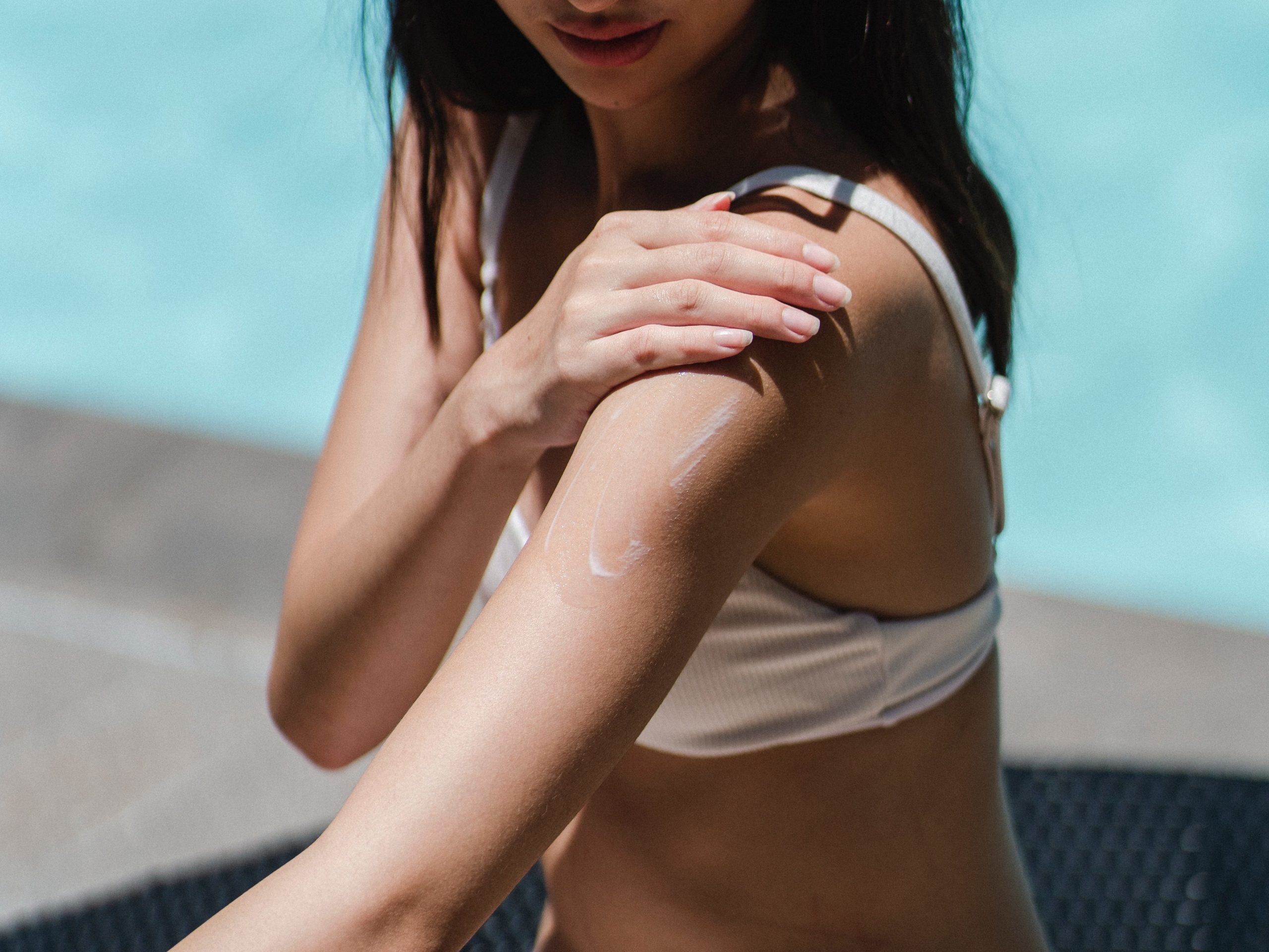How to Choose Your Perfect Sunscreen – Differences, SPF, Environmental Impact, and More
Sunscreen, in an ever-heating climate, is vital. Even as fall comes around, we must continue using and applying sun protection to stay healthy and happy. How do we choose the perfect sunscreen though? With so many options on the market, it can be overwhelming.

Check out this guide on how to choose the perfect sunscreen for you. Everyone has different needs, skin sensitivities, and preferences, so this will provide all the information you need to make the right choice. Learn about what SPF is, the difference between chemical and physical sunscreens, and why we even need them in the first place!
Why We Need Sunscreen
Sunlight contains ultraviolet radiation, which is not visible but has more energy. It consists of UVA, UVB, and the uncommon UVC. UVA has the longest wavelength, whereas short UVC waves never reach the earth’s surface. UVB enters the top layers of the skin and UVA can penetrate deeper layers.
Sun Exposure
Some sunlight is good, as small doses of UVB help us make the sunshine vitamin, vitamin D. This vitamin works as a hormone and nutrient, and is essential in absorbing calcium, preventing aches, keeping muscles strong, and much more.
Sunlight, and natural light in general, also helps regulate and maintain our internal clock. This clock is light-dependent and in tune with the hormone melatonin. In the presence of light, melatonin is suppressed and you feel more alert. When the sun goes down and light levels are low, melatonin increases and you begin to feel sleepier. One simple habit you can do to regulate this clock is taking in natural light when you first wake up. Sunlight in the morning tends to be less harsh, can give you a boost of energy, and can even help you feel tired at night when you’re going to bed.
Too Much Sun Though
Exposure to too much sun though, is life threatening. Too much UVA and UVB light damages your DNA, reduces collagen, ages your cells and skin, and puts you at risk of deadly skin cancer.
If you plan to be outside for prolonged periods of time, as in more than 10 minutes, you need to use SPF. Sunscreen comes in many varieties, formulas, and types. Here’s what you need to know to choose your perfect sunscreen.
Factors to Choose Your Perfect Sunscreen
So, how do you choose the perfect sunscreen? First, we need to see how they work and their formulation.
Chemical vs Physical
Sunscreens can either be physical or chemical. Physical sunscreens use inorganic blockers, like zinc oxide and titanium oxide, to deflect UV radiation. Chemical sunscreens use organic carbon-based compounds, like oxybenzone, to absorb UV radiation before it gets into the skin.
Application Method
The application method refers to the form in which the sunscreen is delivered. Sprays, for example, can be convenient when you are wet, but studies have shown that you apply less SPF when you are using a spray compared to when you are using a lotion. Plus, this same study found that inhaling the chemical formula of spray sunscreens may come with potential health risks.
Along the same vein, sunscreen can also come in a stick form, but these also tend to give you less SPF than a lotion formula.
Environmental Impact
It is important to know that some chemicals in chemical sunscreens harm marine life. Coral reefs, for example, cover less than 1% of the ocean surface but are home to 25% of fish species. Chemical ingredients like oxybenzone, butylparaben, and octinoxate contribute to stress bleaching in coral. They kill the algae in coral, reducing food and color while increasing disease in the coral ecosystem.
Reef save is not a regulated term, though, and you can’t always trust a product that uses it on its packaging. Check out this guide here on the environmental impact of sunscreens.
How to Choose Your Perfect Sunscreen
Here’s a small guide on how to choose your perfect sunscreen easily.
1. Look at SPF
Sunscreens should have an SPF of 30 or higher. It is a measurement of how much UVB radiation is needed to give protected skin a sunburn. SPF 15 blocks out 93% of UVB, 30 blocks out 97%, and 50 blocks 98%.
SPF is based on the quantity and quality of sun exposure, meaning a lot of factors go into it including sun intensity, where, time, and your own genetics.
2. Choose Chemical or Mineral
Sunscreen chemicals are approved by the FDA, but research is still going into the ongoing effects on the human body. If you’re worried or have sensitive skin, you may want to reach for a mineral sunscreen. Mineral sunscreens tend to leave a white cast and be thicker, while chemical formulations tend to be clear. Chemical sunscreens, at least those in the US, tend to be less stable, meaning they break down in the sun and need reapplication whereas mineral sunscreens are more photostable.
Some chemical filters, particularly from overseas brands, have chemicals not FDA-approved, so look out for those. The newer chemical filters seem safer, more stable, and less irritating than common chemical filters in the USA. These new filters include Uvinul T 150, Uvinul A Plus, and Tinosorb M. While not available in the US, they are more protective, more stable, and more cosmically elegant.
3. Choose Between Active or Casual Formulas
This refers to whether or not the formulation of sunscreen is waterproof, sweatproof, or resistant. Determine if you need a more active formula. If you’re just going to be outside vibing, no need for a sticky waterproof, hard-to-remove sunblock. However, if you are going into water, or if you are going to sweat, you are going to want a more resistant formula, and you’ll need to reapply more often.
4. Make sure It’s One You’ll Use
At the end of the day, the best sunscreen is one you will actually use. If you have a mineral lotion, but don’t use it because it makes you look like Casper the friendly ghost, find a sunscreen you will use. Even if it is a sunscreen stick, something is better than nothing.
Quick Basic Sun Protection Tips
Here are some quick tips on how to protect yourself from the sun, no matter the climate!
- Use SPF even in cloudy weather – UV radiation still penetrates through clouds. Make sure to use SPF even if it’s cloudy outside.
- Wear protective clothing – nothing is better than a physical barrier from the sun. Use hats, long sleeves, light-colored clothing, and sunglasses to protect yourself from the sun when you can.
- Skip the sun from noon to 3 – this is when the sun is at its most intense. Try to avoid sun exposure at this time.
- Invest in overseas sunscreen – overseas does not mean dangerous! Honestly, the US and Canada are just a bit behind on SPF research. Overseas countries conduct their own research to create and approve different filters, with very promising results. Try out European, Japanese, or Korean sunscreens for more photostability and less irritation.
The Takeaway
Learning how to choose your perfect sunscreen is vital for health and wellbeing. Use this guide to help you find the right formula for you. Try things out and always take care of your skin and health when going into the sun.
Remember that health comes from within, so eat healthy, exercise when you can, and care for your mental health. Good habits form building blocks for emotional, mental, and physical health. Take care of your gut health too! Learn everything you need to know about gut microbiota today for free here.





